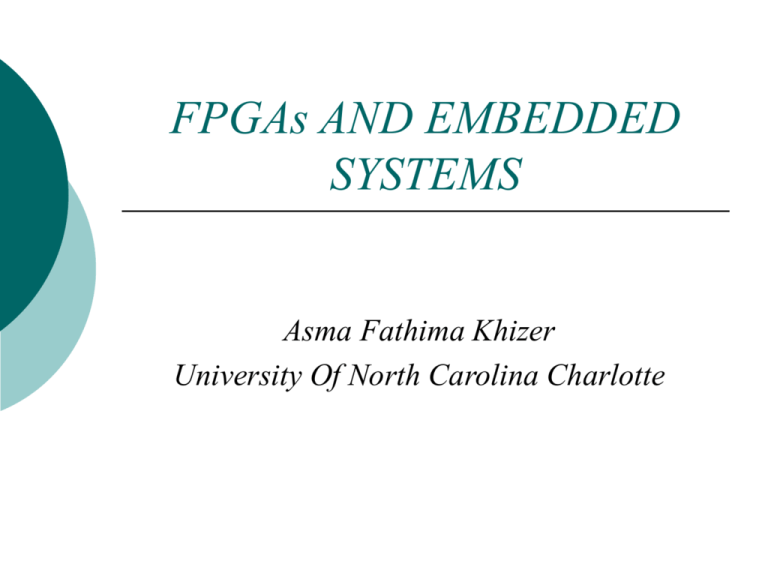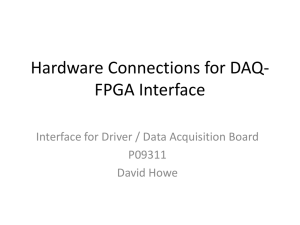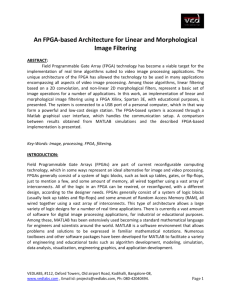fpga and embedded systems
advertisement

FPGAs AND EMBEDDED SYSTEMS Asma Fathima Khizer University Of North Carolina Charlotte Overview Introduction Technical overview Configuration Embedded System design in FPGA Processors Applications What are FPGAs? A Field Programmable Gate Array or FPGA is a semiconductor device containing programmable logic components and programmable interconnects. FPGAs are programmable digital logic chips. It means that we can program them to do almost any digital function. In most FPGAs, these programmable logic components (or logic blocks) also include memory elements, which may be simple flip-flops or more complete blocks of memories. Architecture Basic architecture consists of an array of configurable logic blocks (CLBs) and routing channels. A logic-cell (CLB) is composed of a small lookup table, some gates and a D-flip-flop. Each logic-cell then can be connected to other logic-cells through interconnect resources. Fig: Logic-cell (CLB) Architecture Contd., Each wiring segment spans only one logic block before it terminates in a switch box. Whenever a vertical and a horizontal channel intersect there is a switch box. When a wire enters a switch box, there are three programmable switches that allow it to connect to three other wires in adjacent channel segments. Fig: Switch box topology Architecture Contd., FPGA Pins FPGA pins fall into 2 categories: Dedicated pins User pins About 20% to 30% of the pins of an FPGA are "dedicated pins", which means that they are hardcoded to a specific function. FPGA Pins Contd., Dedicated Pins are again classified into 3 categories: Power pins. Might be ground pins (GND) or power pins (core or IO). Configuration pins. These pins are used to "download" the FPGA. Dedicated inputs, or clock pins. These pins are able to drive large and wide nets inside the FPGA, suitable for clocks or signals with large fan-outs. The rest are user pins. Clocks and Global lines An FPGA design is usually "synchronous". Its means that the design is clock based - each clock allows the D-flip flops to take a new state. Global routing or Global lines, these allow distributing the clock signal all over the FPGA with a low skew (i.e. the clock signal appears almost simultaneously to all the flipflops). To feed a clock to FPGA, a dedicated input pin is used An FPGA can use multiple clocks Pin Assignments Xilinx (uses .ucf files) NET "data" LOC = "P17"; NET "clock" LOC = "P91"; Altera (uses .qsf files) set_location_assignment PIN_10 -to clk set_location_assignment PIN_26 -to LED FPGA Configuration An FPGA can be into 2 states: Configuration mode User mode FPGA Configuration Configuring an FPGA means downloading a stream of 0's and 1's into it through some special pins. Once the FPGA is configured, it goes into "user-mode" and becomes active, performing accordingly to your programmed logic function There are 3 ways to configure FPGA: Use a cable from a PC to the FPGA, and run a software on the PC to send data through the cable. Use a microcontroller on the board, with an adequate firmware to send data to the FPGA. Use a "boot-PROM" on the board, connected to the FPGA, that configures the FPGA automatically at power-up. FPGA Programming The behavior of the FPGA (logic function) can be defined by either a hardware description language (HDL) or a schematic design. Compile the logic function on the PC using the software provided by the FPGA vendor. A binary file is created. Connect a cable from the PC to the FPGA and download the binary file. FPGAs loose their functionality when the power goes away (like RAM in a computer that looses its content). We have to redownload them when power goes back up to restore the functionality. A simple program for D- Flip Flop library IEEE; use IEEE.std_logic_1164.all; entity DFlipFlop is port ( CLK : in STD_LOGIC; RST : in STD_LOGIC; D : in STD_LOGIC; Q : out STD_LOGIC ); end DFlipFlop; architecture behaviour of DFlipFlop is begin process(CLK) begin if rising_edge(CLK) then if RST = '1' then Q <= '0'; else Q <= D; end if; end if; end process; end behaviour; Ref [6] FPGA vs. Microcontrollers Microcontrollers are based on a CPU architecture. As all CPUs, they execute instructions in a sequential manner. FPGAs are programmable logic and run in a parallel fashion. FPGA Manufacturers Xilinx has traditionally been the FPGA leader. Altera is the second FPGA heavyweight. Lattice Semiconductor focuses on low-cost, feature-optimized FPGAs and non-volatile, flash-based FPGAs. Actel has antifuse and reprogrammable flash-based FPGAs. QuickLogic has antifuse (programmable-only-once) products. Cypress Semiconductor Atmel is the only manufacturer whose devices are fine-grain reconfigurable (the Xilinx XC62xx were, but they are no longer in production). They focus on providing AVR Microcontrollers with FPGA fabric on the same die. These factors aside, their devices tend to be smaller and more expensive than other manufacturers'. Achronix Semiconductor has very fast FPGAs in development. They plan to ship in early 2007 and claim they can reach speeds of over 1GHZ. Embedded System Design in an FPGA A typical digital system design involves a significant amount of custom logic circuitry, but also includes pre-designed major components, such as processors, memory units and various types of input/output (I/O) interfaces. In the traditional approach for designing such systems, a new integrated circuit (IC) chip is created for the custom logic circuits, but each pre-designed component is included as a separate chip Different approach for realizing digital systems, called embedded system design. It leverages the advanced capabilities of today's IC technology by implementing many of the components of the system within a single chip, such as a field programmable gate array (FPGA). Technical reasons to use FPGAs in System Design Offer large logic capacity, exceeding several million equivalent logic gates, and include dedicated memory resources Include special hardware circuitry that is often needed in digital systems, such as digital signal processing (DSP) blocks (with multiply and accumulate functionality) and phase-locked loops (PLLs) (or delay-locked loops (DLLs)) that support complex clocking schemes Support a wide range of interconnection standards, such as double data rate (DDR SRAM) memory, PCI and high-speed serial protocols. Processors Two types of processors are available to use in FPGA Hard Processors Soft Processors Hard Processor: A pre-designed circuit that is fabricated within the FPGA chip Soft Processor: The processor exists as code written in a hardware description language (HDL) Advantages of Soft Processors More flexible compared to hard processor. Resources are consumed for processor only when they are actually needed in the system. Multiple soft processors can be included in the FPGA when desired. Embedded system design software tools Two main aspects to the software tools The creation of the system hardware The development of software that runs on the processors included in the system. For creating the hardware circuitry, the tools allow the user to build a system by making use of pre-designed building blocks for processors, memory controllers, digital signal processing circuits and various communication modules (such as UARTs). The software allows easy instantiation of these sub-circuits and can automatically interconnect them on the FPGA chip. The Electronic Design Automation tools generate memory maps for the system, allowing the processor(s) to access the system’s hardware resources. Embedded Software Design Flow for the Nios II Processor Ref [3] Applications Applications of FPGAs include DSP, software-defined radio, aerospace and defense systems, ASIC prototyping, medical imaging, computer vision, speech recognition, cryptography, bioinformatics, computer hardware emulation and a growing range of other areas. They now find applications in any area or algorithm that can make use of the massive parallelism offered by their architecture. Reconfigurable computing is computer processing with highly flexible computing fabrics. The principal difference when compared to using ordinary microprocessors is the ability to make substantial changes to the data path itself in addition to the control flow. References 1. 2. 3. 4. 5. 6. http://en.wikipedia.org/wiki/FPGA http://en.wikipedia.org/wiki/Embedded_System_Desi gn_in_an_FPGA http://www.fpga4fun.com/WhatAreFPGAs.html http://en.wikipedia.org/wiki/Reconfigurable_computin g http://www.qa-talk.com/news/alt/alt100.html http://en.wikipedia.org/wiki/Vhdl THANK YOU





